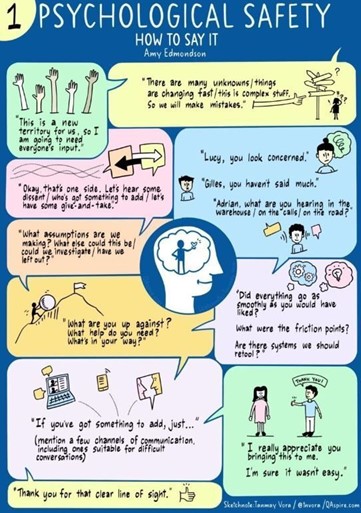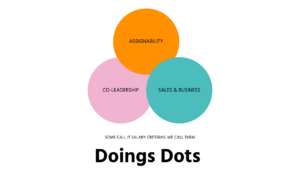A Brain-Friendly Workplace – For Improved Mental Health
A Brain-Friendly Workplace – For Improved Mental Health
All Doers
A Brain-Friendly Workplace – For Improved Mental Health
All Doers
It’s time to prioritize mental health at work!
On October 10th, it’s World Mental Health Day, an initiative started by the World Federation for Mental Health. This year’s theme is “It is time to Prioritize Mental Health in the Workplace.”
At Doings, we couldn’t agree more – it’s time to organize for mental health, even at our workplaces. The theme is more relevant than ever. We are facing challenges (and opportunities) like accelerated digitalization, economic uncertainty, and geopolitical instability. The work environment (and life in general) is constantly changing, and the demands for adaptability and personal development have never been higher.
Why mental health at work is crucial right now
- Blurring boundaries between work and personal life – Since the pandemic, the separation between work and personal life has increasingly faded, as many companies have shifted to hybrid or remote work models. The once-clear distinction between work hours and personal time is becoming more ambiguous, which can create a sense of insecurity for many individuals. As these boundaries blur, employees often find it difficult to fully “switch off,” and we’ve observed that many feel the need to be constantly available. Which can lead to persistent stress and exhaustion.
- Rising mental health issues – Several studies show that stress-related illnesses, burnout, and anxiety are on the rise. According to WHO, mental health issues cost the global economy approximately a billion USD per year in productivity losses. Failing to prioritize mental health in the workplace is not just a moral issue, but also an economic one.
- A generation with high expectations – Today’s workforce, especially younger generations, has higher expectations from their employers when it comes to well-being and mental health. They value work-life balance and want to work for companies that take responsibility for employee well-being.
Proactively addressing mental health
Our sense of security and predictability is being challenged on multiple fronts, which significantly impacts mental health. On average, we spend about one-third of our waking hours at work—over a lifetime, that adds up to roughly 100,000 hours! As employers, it is more important than ever to prioritize structured efforts to support and improve mental health in the workplace. Because we have the power to make a meaningful difference!
The focus should be on working proactively not just to avoid mental health issues but to strengthen and optimize engagement and performance. Neuroscience gives us important keys on how to work and organize ourselves at our workplaces.
A brain-friendly workplace – 4 tips
How can we better tailor the workplace to align with the natural functions of our bodies and brains? What does research consistently highlight as most effective for supporting mental health? Here are four tips from us:
- Adjust workflows to the brain’s natural rhythms. Research shows that our brains function best in cycles of intense work periods of 90–120 minutes, followed by a break. Employers can encourage employees to work in such “sprints” to maximize both efficiency and well-being.
- Create space for mindfulness and meditation. Introduce mindfulness training at work, which is well supported by neuroscience. Mindfulness has been shown to reduce activity in the part of the brain associated with worry and self-criticism, while increasing the brain’s capacity for concentration and calm. A suggestion could be to have a quiet room where people can take mindful breaks.
- Build a work environment that supports cognitive recovery. Neuroscience shows that we perform best in environments that allow intense focus interspersed with cognitive recovery. Workplaces can offer quiet zones for concentrated work, as well as social and creative spaces where the brain can relax and recover. Digitally, we should also ensure spaces for informal chats.
- Focus on the home work environment too. When designing our workplaces with these tips, it’s good to remember that we need to nudge ourselves and each other, even in hybrid environments. This can mean agreeing on breaks even when working remotely and ensuring that the home environment allows for both focus and recovery. It’s also good to remember that those physical safety checks at the office, like making sure no one trips over a cord, are now needed for the home office too!
The benefits of prioritizing mental health at work
Mental health at work is not just a personal issue for employees; it’s a strategic issue for employers. Companies that prioritize mental health see not only increased productivity and lower absenteeism but also higher employee satisfaction and engagement.
At Doings, we are deeply passionate about these topics— not just because they’re important, but because we’re genuinely fascinated by how people function at their best, both individually and in teams. This curiosity drives us to find innovative solutions that continuously enhance workplace engagement, starting with our own.
We’d be thrilled to help you design a brain-friendly workplace that supports your team’s mental health. Give us a call or reach out to hej@doings.se – we’d love to chat!
All Doers
Share this post
Future Competitiveness is Everyone’s Responsibility
Future Competitiveness is Everyone’s Responsibility
All Doers
Future Competitiveness is Everyone’s Responsibility
All Doers
Nowadays, almost all of our client engagements revolve around a common theme: strategic workforce planning. Whether it’s employer branding, culture, communication, sustainability, or leadership, the skills of tomorrow are always a critical factor for long-term success and business performance.
Ownership
We’ve made a couple of observations. Or perhaps the first is more of a challenge. In many organizations, strategic workforce planning is still seen as an isolated HR issue—something the “HR department should handle.” Given that strategic workforce planning permeates almost every aspect of the business, this is a rather poor starting point. Thankfully, our second observation is more promising: more and more organizations are realizing that long-term competitiveness is not just built on the right products, technology, or business models. It’s built on how well we mobilize, engage, and develop our employees’ capabilities—for their wellbeing, but most importantly, for the company’s performance and future competitiveness.
In today’s rapidly shifting technological landscape, changing demographics, uncertain global conditions, and employees seeking more than just a paycheck, one thing is clear: workforce planning is no longer an HR silo. It’s a business-critical, strategic issue for the entire organization. To meet this challenge, we need a new approach to workforce planning that connects directly to performance management and overall talent management.
What is Strategic Workforce Planning – Really?
Let’s be honest: the term “strategic workforce planning” doesn’t exactly make anyone’s heart race. It sounds dry, bureaucratic, and mechanical—as if it’s just about placing the right skills in the right positions, without engaging people or unlocking their potential. And as if we already knew exactly what skills we need. That might have been the case in the past when HR could skillfully manage workforce planning and succession planning. But today, we need skills that universities haven’t even identified yet, and that companies are still struggling to define.
What if we started talking instead about “competence-driven growth” or “future capacity”? These might not be perfect terms either, but they signal something different—that we’re talking about development, innovation, and competitiveness, not just administration.
Workforce Planning – A Shared Responsibility
Workforce planning is no longer something that can be delegated to one part of the organization. It needs to be integrated into every strategic decision—from business development to budgeting processes and growth strategies. Leadership must collectively identify and clarify which competencies are crucial for the company’s competitiveness and anchor these in the business plan and the entire organization.
And let’s not forget the power of collective learning and sharing! Talent management isn’t just about developing one’s own skills—it’s about fostering a culture where everyone takes responsibility for their own growth as well as their colleagues’. This collective learning is one of the most powerful drivers of engagement. And as we know, engagement fuels both innovation and performance.
Forward, Upward!
It’s time to rethink how we talk about and work with strategic workforce planning. It’s no longer just about identifying the right competencies. It’s about linking them directly to the strategy, unlocking potential, and ensuring that both individuals and organizations grow together. Future competitiveness isn’t just about having the right people in the right place—it’s about securing the entire business’s future by creating a culture where talent thrives, and the whole company takes ownership of its growth.
All Doers
Share this post
Leading with Trust in both Good and Bad Weather
Leading with Trust in Both Good and Bad Weather

Lena Noaksson
Getting employees to enthusiastically follow when everything is going smoothly and the sun is shining isn’t necessarily difficult. However, I believe we often ponder over how challenging it is to lead when circumstances are reversed. When there’s a storm brewing. But is it really so? Have we simply overlooked doing the groundwork – building a trust-based culture?
I dare say that there’s no need for any other keys to successful leadership in a more demanding climate. Not even in more negative change processes such as reorganizations and downsizing processes!
Even in adversity, leadership is about working towards a culture of trust where we create conditions for everyone to be able to, want to, dare to, and understand how we can contribute and engage in what lies ahead.
What is needed is for you as a leader to simply have done your foundational work as a leader before the storms start – you need to have spent at least 20% of your actual time on trust-building activities to build a trust-based culture!
So, honestly, dear leaders, have you done the following to create a trust-based culture:
- Regular conversations with your employees where you manage expectations regarding what you appreciate in their performance and personality, as well as what needs to be developed
- Found out what needs your employees have to contribute in the best way to desired change?
- Transparently informed about everything, all the time?
- Received feedback on your leadership and actually developed your leadership?
- Received input and had dialogues with your employees on how you can become even better together?
- Shared the word and created opportunities for participation – giving everyone the opportunity to contribute with knowledge and opinions (even those who take up the least space)?
- Highlighted good examples and behaviors (which make it easier for others to do the same)?
- Shared (personal) failures and understood the value of turning this into lessons?
- Ensured that you work to maximize each employee’s individual development. So that they are even more employable when they leave your team than when they started?
- Genuinely tried to get to know each person in your team so that you can facilitate co-leadership in the best possible way?
Do you have a score of 10 out of 10? Congratulations – your culture of trust will weather any storm!
Read more here about how we supported a customer in transition.
Do you need support, encouragement, or inspiration in managing a downturn, reorganization, and/or downsizing process? I’m happy to offer you a coffee and discuss further how we can help you build a trust-based culture.
Lena
Share this blog
BEING on an executive team or WORKING together on an effective executive team?
BEING in an executive team or WORKING together in an effective executive team?
Kristina Vallin
BEING in an executive team or WORKING together in an effective executive team?
Kristina Vallin
My early perception of executive teamwork might have been somewhat naive; to collectively create innovation, future visions, results for the ENTIRE company. To collaborate deeply with each other and be inspired by different perspectives, fostering effective executive teamwork. And indeed – there have been some really nice glimpses of that, but mostly I’ve been SITTING in the executive team. Not WORKING together, using our full potential as a team. Most of the time has been long stretches of very low contact and collaboration between the different parts of the group. Executive teamwork as a veritable reporting bunker instead of the collaborative and effective team that an executive group should strive to be.
Effective executive teamwork
Here are three puzzle pieces that effectively develop executive teamwork. These have truly helped me, both as a member of the executive team and in my role as a consultant helping executive teams to develop further. Puzzle pieces that move executive teams from being decisions concerning Christmas parties and reporting on own KPI:s, to strategic collaboration champions with responsibility for the whole.
Essentially, there are three questions that need to be answered; Why? What? and How?
Why does the executive team exist?
An exercise we at Doings usually do to sharpen the question of why the executive team (or the organization/team/business area/product/brand) exists, we call “R.I.P. The Executive Team”. A somewhat macabre title perhaps, but oh so effective as an exercise. It involves the group members putting words to what would be missing in the organization if the executive team disappeared right now.
The answers to the question can range from clear strategic leadership to cultural role models or enablers. In the next step, the group reflects on whether this is a desired or actual image. If it is desired (which it usually is), then the work is to define the steps to get there. A first puzzle piece in executive teamwork is now laid.
What is your common mission in the executive team?
I am still amazed at how many people never consider what the common mission of the executive team is and where it comes from. If you ask the question about the mission in an executive team, you will probably get almost as many answers as there are members.
In most cases, the executive team describes its mission based on the sum of the individual members’ different roles and missions. 1+1=2. And that is usually how incentive structures are built – to reward silo structures rather than the whole. This means in practice that the individual needs to report on the KPIs they are measured against.
But that is just part of the truth. The other part, and in the context of executive teams, the superior one, is the role as an executive team’s member. It’s something else and more, where 1+1= 33. It’s a role and mission where everyone wears the company hat (the whole), and where my own area (the part) is not primary. And how do you define that mission? It’s valuable to truly formulate the common mission in writing.
The executive team’s agenda
A corporate leadership has a responsibility for the whole, which also defines which issues should be on the agenda. Is this the forum for the Christmas party or rather for the overall culture? Can you critically look ahead? I.e., can you kill your darlings if it turns out to be a successful strategy for the whole company in the future? How do you view your brand and where it’s heading? I.e., how do you want current and future customers and employees to perceive you, and what can you as an executive team give each other to succeed as a whole?
When the agenda reflects the strategic level you as an executive team want to be at – then you have the second puzzle piece in place.
How do you create the results you want?
Who hasn’t been in a situation where awkward silence appears when someone challenges a bit too much, or just speaks their mind? Or, in the worst case, ridicule, rolling eyes, and deep sighs over that annoying person who never just goes along but always has objections or new perspectives.
A secure and stable executive team with the ability to handle disagreements in substance and make good use of each other’s different personalities also becomes a catalyst for results and a secure, creative, and productive organization. The executive team is literally always on stage. And the more openly you stand together and not as solo singers – the clearer you become as role models. So, it matters A LOT how you communicate within the group and outwardly in the organization. And the foundation of that lies within your effective executive teamwork.
Ground rules
A success factor for working with the “how”: i.e., articulated expectations you have of each other in meetings and in communication, is to define your ground rules. It’s a process that requires facilitated dialogue with both reflection, discussion, and decision-making. It can be difficult to see and articulate your own group’s dynamics and to facilitate them when you are a member of the group. Seeking help from a team coach or leadership developer in this process is recommended. Research shows that executive teams that seek support in this process significantly improve their effectiveness.
Ground rules are about ensuring that the culture you want the organization to have, also is reflected in the executive team’s collaboration. And culture is simply how you behave towards each other. So, ground rules are the set of behaviors you agree should apply for your effective executive teamwork, so that you live as you pray. Et voilà – puzzle piece number three in place! Now you’ve come a long way to get a much more enjoyable, maybe even joyful, collaboration in the executive team.
How do you do it?
Don’t set too many ground rules at the beginning, a handful may suffice. Some tips on ground rules and advice along the way:
- In the beginning, maybe it’s about hygiene factors in meeting habits? Such as prioritizing your meetings, being present, letting the phone be silent and off, and being well-informed about the topics to be discussed, etc.
- Ensure to discuss your communication on topics like which platforms to use for what topics, when you can expect responses from each other, how you handle urgencies et c. Also, discuss whether you should be expected to be online 24/7 or if there should be limitations. As mentioned, you’re building a culture for the entire company in how you behave in the executive group – so be mindful and diligent about what you create together.
- Ground rules mean nothing if they’re not followed up. Follow-up creates security! You must be able to give each other quick and constructive feedback when someone doesn’t play by your rules. And perhaps most importantly – heaps of positive feedback when you see someone struggling with a behavior and making progress.
- After a while when the ground rules are in place, it’s time to add new ones. Ground rules are alive and should evolve with you as a team. Maybe now you’ve come more to the level of how you treat each other? Maybe the ground rules are now about using your curiosity instead of your preconceived ideas? To use trust before control? To give feedback after each agenda item or meeting, etc.
Do you still think this sounds like a big challenge for your group? Don’t be a stranger – we’ll show you how we can coach your executive team on these issues. It’s fun, challenging, but above all, effective!
Kristina Vallin
Kristina Vallin
Share
Psychological Safety - no darn cuddle fest!
Psychological Safety - no darn cuddle fest!
Leila Ljungberg
Psychological Safety - no darn cuddle fest!
Leila Ljungberg
Finding the magical recipe for psychologically safe teams and organizations is something most organizations aspire to, thanks to its many proven effects and benefits. Even though most of our clients are curious to understand more, we (almost) always encounter a few managers who start squirming in their chairs when we talk about psychological safety.
The concern always revolves around similar reasoning: That it’s going to become overly nice here, that it will no longer be okay to set standards, and that no one will “perform” anymore.
Before we delve further into psychological safety, it’s high time we also talk about what it isn’t. No one says it better than The Queen of Psychological Safety herself – Amy Edmondson:
Psychological safety is NOT about:
- Being nice
- Job security
- A guarantee that all ideas will be applauded
- A license to whine
- Freedom from conflict
- Permission to slack off
So, what is psychological safety?
Psychological safety can be simplified as an environment where everyone can express what they think and feel without fear of negative consequences. The effects when successful are numerous, such as increased creativity and efficiency, enhanced learning, more satisfied customers, and satisfied, high-performing employees, to name a few.
For an organization to achieve real success in a world where creativity and innovation are crucial to success, it’s not enough to hire smart and driven employees. Not even the best employees can contribute 100% of what they’re capable of at all critical moments. Sometimes it’s because they don’t realize the need for their knowledge, but more often it’s because they don’t want to stand out, make mistakes, or clash with their boss or colleagues.
For the work to be successful, the workplace must be such that everyone feels they can share their knowledge and ideas. That’s precisely what the concept of psychological safety is all about.
Kindness vs. Performance
If you think about a team where you’ve experienced being your best self, a team where everyone dared to speak their mind – would you then say it was a climate that was kind but without performance? In the examples that pop up in my head, it’s the most high-performing teams that have had the highest psychological safety.
And it hasn’t always been “nice” – quite the opposite, quite a few doses of tough love, you know – tough love. Straightforward feedback but with the best of intentions, focusing on refining and improving the outcome and growing together along the way.

Experiment Your Way Through
To create a psychologically safe environment, it’s crucial how we express ourselves. Like when we have different opinions or need to give feedback. But above all, when we receive a feedback or input from someone who dares to come forward or just takes on another perspective. It’s not always easy, but we must do our best in not punishing or diminishing initiatives like this.
I know it can feel a bit scary and difficult to find new ways to respond and react. But one idea might be to actually give ourselves a dose of psychological safety. What if we, with all the empathy we can muster, try to learn, experiment, and play our way to new ways of interacting with each other?
If we dare to give ourselves space to learn? Can we ask to have a trial conversation and think a little so that it feels safer to try? Can we give ourselves the space to say “I need to think about how to respond a bit.” Or “That was wrong, I’ll try again.”

Think Like a Scientist
Speaking of experimenting – challenge yourself to think like a scientist. The difference between a classic manager and a managerial scientist, according to Amy Edmondson, is that:
- A manager provides answers, while a scientist asks questions
- A manager specifies results, while a scientist shows direction
- A manager supervises and evaluates while a scientist sees opportunities and makes data understandable
- A manager rewards achieved goals while a scientist welcomes mistakes and celebrates discoveries
- And, most importantly – a manager isn’t dependent on psychological safety, but a scientist is.
Because this is the whole key message of psychological safety; to create secure, learning environments where we can perform at our very best, grow together, and become even better! That we perform better is a fantastic thing about psychological safety, but that we enjoy it, learn, become more innovative, and develop is perhaps even more wonderful.
In conclusion, a few more tips on the topic of psychological safety:
- Want to read more about the more scientific definitions of psychological safety? Wikipedia has it.
- Want to watch Amy’s fantastic TED Talk on psychological safety? Click here!
- Want to delve deeper into misunderstandings about psychological safety and the risks associated with it? Click here.
Want to know more about stable vs. fluid teams and psychological safety? Read this article. - Want to be inspired in a lighthearted way by a leader who creates psychological safety? Read Emma’s blog and series recommendations here.
- Want your team/company to get better at psychological safety? Send a love letter here.
Leila Ljungberg
Share post
"What have you done to us?" - a voice from Alleimas Leadership Program
"What have you done to us?"
Kristina Vallin
What have you done to us?
Kristina Vallin
“What have you done to us?!”
The participant smiles while saying this during the final check-out round after three intense leadership learning session days at #högbobruk in Sandviken. The others start giggling, nodding their heads.
The content of this program has been worked out in deep collaboration with Alleima during 6 months. This resulted in clear and well anchored learning goals connected to the Alleima strategy and long term goals, a substantial digital training and well designed physical learning sessions. 100 leaders will have passed the program this year. It is clearly an understatement that project leadership skills have been key in rolling this out!
So what did he mean “done to us”? It gives the connotation of being subject to influence rather than co-creator of learning. And yes, we really did design the entire program to enhance self-leadership and autonomy. Well – it was so simple it could really have gone lost in translation.
Me and my brilliant co-facilitator Peter Röjhammar usually meet a lot of managers that stay mainly in their heads, not using their emotional skills to a larger extent. And for this group it would have been understandable if they did – language barriers, new people, new country, new food etc, you got to keep your guard up a bit. But we really wanted them to experience how using your emotional skills can help opening up and start collaborating on a deeper level, co-creating psychological safety, enhancing learning and so on. So we encouraged our participants to take a silent break for 30 minutes. No talking, no interaction with other people, phones, computers, music, books, anything but walking in the beautiful nature surrounding Högbo Bruk.
And yes! This, at first sight, small change added so much more value than we could have ever expected. For many of our participants silence and reflection is a scarce resource. For some silence only occurs when using noice cancelling headphones, or maybe at night when parts of the city sleeps. And reflection then – very occasionally and almost never as a planned activity.
So – what did we learn? Of course the obvious – that learning design needs to follow the needs, attitudes and behaviours of the participants, and that reflection can come in different shapes; talking, writing or just being with yourself for a little while, observing your feelings, observing the surrounding. The most important though may be that we as facilitators underestimated the power of time spent on reflection. We thought they would be tired of reflecting after these three days, however it seems like the opposite where reflection together in teams, with your learning buddy or for yourself have given new energy and tons of new insights about how to deal with all different dilemmas in the daily business.
And for me and Peter – we are just even more humble and grateful for experiencing people connecting with themselves and with others for a more positive and sustainable future. Thank you Alleima leaders for this – you know who you are 💫🙏
Kristina Vallin
Dela inlägget
Payed to live our Values
Payed to live our Values

Emma Forsgren
For me and all of us at Doings, one of the most important things is to practice what we preach – to stop talking and start doing. Of course, this applies to our values and our culture as well – and to have structures that make it easy to do the right thing. Part of this work involves having salary criteria that reflect this. Our values aren’t just a few words but a clearly formulated compass in our LEVA principles:

- Value trust over control
- Value personal engagement over documented knowledge
- Value relationships and collaboration over processes and tools
- Value co-leadership over hierarchical leadership
- Value results over methodology
- Value initiative and action over detailed planning
- Value well-being over financial results
(LEVA is a play on words with Doings’ founders LE (LEna) + EVA (VA), aiming to emphasize well-being, having the energy to live fully, both at work and in life in general. By the way, don’t miss the opportunity to play with words, we believe 😉)
Salary Criteria
These LEVA principles guide us right 11 times out of 10! Except when it came to our salary structure, as I wrote about last week. So, as we finally revamped it, focusing on sustainability, collaboration, and well-being, it was high time to also clarify how we determine salaries. We had been a bit lax about that too, of course. Not about setting it in a sensible way, naturally. But about making it clear, transparent, and as straightforward as possible. (The cobbler’s children, you remember.)
And when it comes to our salary criteria, I’m possibly a little extra proud, as we have a clear expectation regarding culture – to practice what we preach. One-third of the base salary is actually based on just that!
Salary Criteria and Salary Criteria…
We call them our Doings Dots 🙂 The term “salary criteria” even made the cobbler and family yawn. The Doings Dots consist of three parts: Believability, Co-leadership, and Sales and Business.

Our existence, our freedom, and our salary determination are based on our long-term ability to secure our revenue. We do that in several ways. Invoicing is the clearest and most important. But without focusing on the other aspects, we don’t have much to invoice. Our strengths include our commitment, our competence, our curiosity and our constant desire to learn, our relationships, and our LEVA. All of that plays a role when we set and evaluate our base salaries.
Assignability
The higher the “Assignability”, the less financial risk. An important factor in our salary determination is, therefore, the ability and experience to take on various types of assignments. Assignability is about the experience, competence, and consultancy skills to handle a variety of assignments. And of course, to deliver in a Doings way – i.e., with 110% focus on the customer, quality, creativity, and value.
Co-leadership
Our ambition and success lie in working in teams in various ways. Co-leadership means leading oneself but also leading each other, e.g., collaborating and developing competencies and businesses as doers and as an agency. Everyone is a culture cbuilder and engagement spreader – contributing to maintaining and developing Doings’ culture. Making others, including our customers, feel appreciated, helping them develop and feel like heroes, gets us bouncing out of bed in the morning. Additionally, taking responsibility for oneself, being there, supporting each other, and being LEVA and Doings ambassadors in action and behavior. All of this is super important to us and something we constantly strive for.
Sales and Business
Sales are a prerequisite for our business, and money is our freedom. Money isn’t the reason we live, but it’s our oxygen. Our sales strategy and success lie in digging where we stand and spreading our commitment and knowledge, inspiring and daring to challenge. In the Sales Dot, networking and ensuring that we maintain great relationships with customers during assignments and see new opportunities are included. Always wearing the Doings hat and thinking holistically and financially sound. And we always challenge ourselves to find new customers and exciting assignments – for ourselves, for others, and for our agency.
Continuous Development
None of this is hardly the final answer. Everything is an iterative process. We evaluate along the way and adjust together. Now we have a good start and excellent conditions for our continued growth – with clarity, collaboration, development, and what we truly value in focus – win-win-win for both Doings, all doers, and our customers’ development!
/Emma
Share this Blog
A Compensation Model to Reward What We Value Most
A compensation model to reward what we value most

Emma Forsgren
Finally, a new compensation model!
Ever since I joined, Doings, I’ve had a nagging feeling, something that just didn’t fit right. My unease revolved around our compensation model and how it failed to align with our values.
From day one, we’ve fostered an exceptional culture, with clear values, outstanding collaboration and sky-high engagement. Moreover, we’ve been guided by our beacon of LEVA – balancing work and life sustainably over time. We prioritize well-being over financial results (though when necessary, we do focus on financial outcomes).
The issue lies in the fact that, somewhat inadvertently, our compensation model hasn’t mirrored the culture and values we hold dear. Essentially, we’ve had a compensation model that, in theory, incentivizes behaviors diametrically opposed to those we aspire to. Foolish? Absolutely, and somewhat embarrassing too.
The cobbler’s children
We’re masters of change management for goodness’ sake! Daily, we assist our clients in creating the best conditions to activate desired behaviors within their organizations. One of these conditions involves removing organizational obstacles so that culture, structure, and behaviors are synchronized and aligned.
Instead, we, like many reputable consultancy firms out there, have operated under a commission-based model. The more an individual bills, the more they earn. Working an extra project on the weekend (farewell to LEVA) is rewarded on the 25th. Opting not to help a colleague grants more time for personal billing. I must add, though it’s rarely if ever happened, it’s certainly ripe for occurrence. Additionally, this has resulted in a slew of tedious administrative tasks, such as monthly “who did what” reckonings. Such tasks can easily dampen the spirits of even the most enthusiastic team players.
Structuring for growth
So, our compensation model hasn’t bred undesirable behaviors. We owe that to our magical culture and incredibly talented and committed team of doers. But what happens as we expand? The larger we grow, the more vital these structures become, clarifying the culture we espouse and wish to cultivate. What about during challenging times? That’s when structure becomes especially crucial, guiding us in the behaviors we want to foster.
Indeed, we have structures that guide us clearly. We have our fundamental principles that steer us every day. We have an explicit goal to be capped at 75% utilization to allow time for everything else – self-development, packaging our services, team building, balancing life and logistics, and so on. So far, so good! Now, we just need to reflect this in our compensation model too.
Team before self
Something had to be done! Every day, we live by the motto of making things happen, to stop talking and start doing. To test, evaluate, iterate, and get it right. But when it comes to our personal finances, it’s crucial to respect the need for thorough anchoring of any change. It’s about careful consideration, calculation, and discussion beforehand. It’s not just a matter of flipping a switch.
We were on the brink of implementing changes a year ago. Then, a little thing called a pandemic demanded all our attention. But today, I’m bursting with pride to announce that Doings has bid adieu to individual commissions! As of February 1st, we now have a clearer base salary and a team-based commission. It’s tied to our collective performance, not individual billing. Naturally.
Win-win-win
But why have a commission-based salary at all, you might wonder? Isn’t that an outdated tool from the sales world and a time when it was believed that the more you paid, the more engaged employees you’d get? That may be the case sometimes. But for an entrepreneurial, unpredictable consultancy like ours, where costs, success, and revenue are entirely linked to each employee, it’s a good way to create a win-win-win scenario. What benefits the client benefits Doings, which benefits the employee. It’s a means to share both risk and success. It makes our work more enjoyable and strengthens us as a team even further.
The new compensation model makes it even clearer that what we build together is thanks to everyone’s contributions. Therefore, success should benefit everyone. Plus, it makes celebrating success a bit more fun. And we believe in celebrating as often as possible!
Next steps
What obstacles do you face that need clearing to truly let your culture and purpose soar? Do you need help thinking outside the box? Do you want to bounce ideas about change projects in general or incentive structures and compensation models, in particular? Reach out, and let’s grab a coffee 😊
/Emma
Blog two out of two in this series is available to read here – Iit’s about the basis on which we set salaries. We’ve defined a clear expectation of contributing to the culture – living what we preach – and have based one-third of the base salary on just that.







